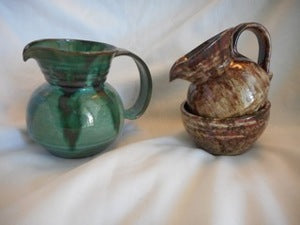The company, Homer Laughlin, introduced a new line of dinnerware in January 1936. The highlght of this everyday ware was its vivid selection of colours.
The original Laughlin pottery started in 1871 in East Liverpool, Ohio. Like most potteries, it has gone through a series of ownership and location changes. In 1929, the production plant settled in Newell, West Virginia. Homer Laughlin still produces today and is known for many well known dinnerware lines such as Fiesta, Harlequin, and Riviera. There is a factory outlet museum in Newell.
Fiesta was designed by Fredrick Rhead. The goal was to produce a colourful dinnerware with a modern streamline look.The recognizable twin concentric rings were added to the edges as modest ornamentation. They started with five colours - red, blue, green, yellow, ivory. Red was the most expensive colour and due to the uranium content was discontinued during World War 2. Red also has had its controversy over health issues which have been proven false. Turquoise was eventually added as the sixth colour. Over the years, many colours including experimental ones have been produced. Less popular colours have been discontinued. In 1950, light green, dark blue, and old ivory were dropped. However, forest green, rose, chartreuse, and gray were added. The other attraction of Fiesta was the number of items available. Early catalogues list 54 items - plates, bowls, coffee/teapots, salt peppers, candlesticks, carafes, ice water pitchers, nappies, ashtray, and vase.
Check here for in stock Fiesta ware !
Fiesta trademarks vary over the years. some are indented in in mold casting. The ink mark is placed with a hand stamp on the glaze. the word “Genuine” was added in 1940 due to competitors copying the style. You will see similar tones in Bauer China. Some smaller items are not marked such as egg cups, salt peppers, demitasse cup/saucers. Other Fiesta style lines include Kitchen Kraft, Ironstone, Casuals, Decalware. Some of these lines only lasted a few years. Fiesta itself was discontinued in 1973 but revived in 1986 at the impetus of other companies producing similar lines such as Moderna by Mikasa. New Fiesta was launched with a set of new colours and shapes such as clocks. Still as vibrant as in 1936.
Fiesta ware in store




